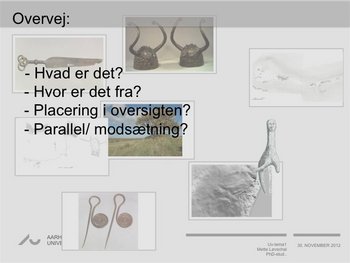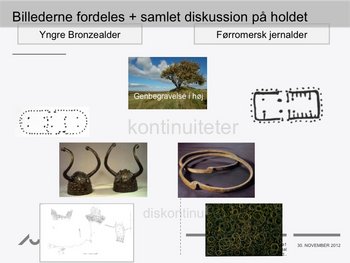This is one of the first university courses that the students complete after their secondary school education. The objective with the course is to provide them with a systematic overview of prehistoric cultural development from the last ice age and up until the year 0.
A very large part of the degree programme consists of self-study, which places special requirements on the need to be able to organise knowledge in a different manner. The students experience difficulties in focusing their self-study and reading in relation to the exam.
The course has a very large syllabus which covers a period of more than 15,000 years. The students can therefore easily lose their perspective.
You can either use the activity in the beginning of a course or in the end of a course. If you use it in the beginning, it will show how much the students already know. If you use it in the end, it will function as preparation for exams. In this example of practice I have used it in the beginning of a course.
The lecturer prints A2/A3-sized sheets, which are for organising the images that are given to the students. The sheet is divided in half, with 'Younger Bronze Age' on the left-side and 'Older Pre-Roman Iron Age' on the right-side (see illustrations in the box on the right).
The lecturer prints a total of 40-60 smaller images (approx. 10 per A4-sized sheet) illustrating various phenomena/material culture from the Younger Bronze and Older Pre-Roman Iron Age. It is an advantage if each image has at least one counterpart from the other period, e.g. a floor plan from both the Bronze- and Iron Age, as well some elements from the transition phases, e.g. a picture of a vessel from both the Bronze- and Iron Age etc.
The students are divided into groups of three and each group is given an A2/A3-sheet and a set of images. These sets are the same for all the groups. The students must now take each image and place it in the overview and reach a proposal for:
The students must continue until all the images are placed on the A2/A3 sheet.
Finally we collect all of the images one by one for each group and place them in a PowerPoint or similar, before discussing the function and dating of the item, as well which image could be its counterpart. There is not necessarily any 'right' or 'wrong' answer to the latter, but it will contribute to the students reflection on change, continuity and forms of transition between the two periods - also preferably across the standard forms of articulation/explanation.
You create a confidential atmosphere in the room, as everyone comes to contribute to the group discussion in turn. The game gives rise to a recognisability in the material when the students subsequently revisit the images in the syllabus. The emphasis is placed on reflection and discussing a range of issues and contexts/discontinuities across the courses, which the students would not otherwise be able to read up on.
The game can easily be adapted to other courses and subject branches:
To get the students to reflect on the material across the usual changes of period and categories by achieving some results through 'play', and to create familiarity and recognisability with the new material. Also the activity gives the lecturer an indication of how well the students have understood the material and any gaps in their knowledge that need to be followed-up on. The method therefore works really well as part of the first lesson of a new course.



